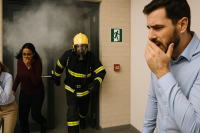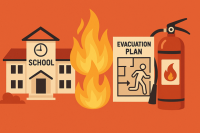
As global concerns about climate change and resource depletion grow, the construction industry is increasingly embracing sustainable practices. These efforts aim to minimize environmental impact by reducing energy consumption, conserving water, and using eco-friendly materials. At the same time, fire safety remains a fundamental requirement of building design, protecting lives and property from potentially catastrophic events.
Although these two priorities may appear to conflict, they are both essential. The challenge lies in finding ways to integrate them without compromising either sustainability or safety. This balance requires innovation, collaboration, and a deep understanding of both fields.
The Rise of Sustainable Building Practices
Sustainability has become a central pillar of modern construction, driven by the need to reduce environmental impact and improve the quality of urban life. Sustainable buildings are designed to minimize their carbon footprint while promoting energy efficiency and waste reduction.
One major aspect of sustainable construction is the use of environmentally friendly materials. Products like bamboo, cross-laminated timber (CLT), and reclaimed wood are gaining popularity due to their low carbon footprint and renewability. Similarly, modern insulation and glazing technologies reduce energy loss, while modular construction methods help limit waste during the building process.
Sustainable construction also incorporates renewable energy solutions, such as solar panels and wind turbines, and water-saving techniques like greywater recycling and rainwater harvesting. Together, these efforts contribute to creating healthier, more efficient buildings.
However, some sustainable materials—especially natural ones like untreated wood—are more flammable than conventional options. This raises concerns about whether these materials can meet stringent fire safety standards without compromising environmental goals.
Fire Safety: An Essential Priority
While sustainability is important, fire safety remains non-negotiable in construction. Buildings must be designed to prevent fires, slow their spread, and provide safe evacuation routes for occupants. These goals are achieved through a combination of active systems, such as sprinklers and alarms, and passive systems, like fire-resistant walls and barriers.
Fire safety regulations are typically strict and comprehensive, reflecting the high stakes involved. Fire-resistant materials, such as concrete, treated steel, and gypsum board, are commonly used to meet these requirements. Passive fire protection features, like fire doors and compartmentation, are designed to contain flames and smoke, buying critical time for evacuation and firefighting efforts.
However, traditional fireproofing methods often conflict with sustainability. Fire-retardant chemicals, for example, can be harmful to the environment, while some fire-resistant materials are non-recyclable or energy-intensive to produce. This creates a pressing need for alternatives that align with both safety and environmental objectives.
The Intersection of Sustainability and Fire Safety
The tension between sustainability and fire safety often centers on materials. Many eco-friendly options, such as untreated timber and bio-based composites, are combustible and require additional treatments to meet fire safety standards. These treatments, in turn, can reduce the environmental benefits of the materials.
Regulatory frameworks add another layer of complexity. Building codes designed to prioritize fire safety may restrict the use of certain green materials, while certification systems like LEED or BREEAM emphasize sustainability. Striking a balance between these standards can be challenging, especially for innovative projects.
Lifecycle considerations further complicate the equation. Fireproofing measures must not only meet immediate safety requirements but also avoid long-term environmental harm, such as generating waste or contributing to pollution.
Innovations Addressing the Balance
Despite these challenges, significant progress is being made in integrating sustainability and fire safety. Researchers and developers are creating materials and systems that satisfy both criteria, paving the way for safer and greener buildings.
One major breakthrough is the development of fire-resistant timber. Products like treated cross-laminated timber and laminated veneer lumber offer the aesthetic and environmental benefits of wood while meeting fire safety standards. Similarly, advances in eco-friendly fire retardants are reducing the reliance on toxic chemicals, with natural alternatives like clay and plant-based compounds showing promise.
Smart technologies are also transforming fire safety. IoT-enabled sensors and automated response systems can detect and manage fires more efficiently, reducing the need for large-scale chemical extinguishing agents. Meanwhile, recyclable fireproofing materials, such as mineral-based insulation, align with the principles of sustainability.
These innovations demonstrate that sustainability and fire safety are not mutually exclusive. With continued investment in research and development, the gap between these priorities is narrowing.
Strategies for Achieving Balance
Successfully balancing sustainability and fire safety requires a holistic approach, starting from the earliest stages of a project. Collaborative design processes are essential, bringing together architects, engineers, and fire safety experts to ensure that both goals are addressed simultaneously.
Material selection is another critical factor. Combining sustainable and fire-resistant materials can yield hybrid solutions that meet both criteria. For instance, using treated timber alongside concrete or steel provides structural integrity and fire resistance without sacrificing environmental benefits.
Performance-based building codes offer additional flexibility, allowing designers to achieve fire safety outcomes without being restricted to prescriptive methods. This approach encourages innovation, enabling the use of advanced materials and techniques.
Education and training also play a key role. Builders, designers, and regulators must stay informed about emerging technologies and best practices that enhance both sustainability and safety. Regular audits and maintenance ensure that fire safety systems remain effective over time, while sustainable maintenance practices further reduce environmental impact.
A Unified Vision for the Future
The construction industry is at a turning point, where sustainability and fire safety must coexist to address the demands of a changing world. By embracing innovation, fostering collaboration, and adopting long-term thinking, builders can create structures that are environmentally responsible, resilient, and safe for their occupants.
This integrated approach not only meets the needs of today but also sets the foundation for a future where buildings protect both people and the planet. As urbanization accelerates and environmental challenges intensify, balancing these priorities will define the success of modern architecture and construction.





Leave A Comment